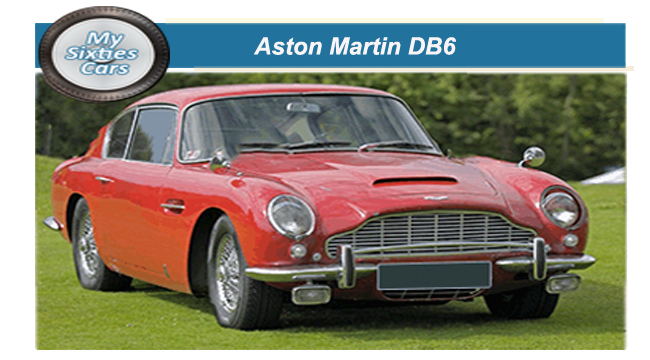
Of all the six-cylinder Aston Martins, most enthusiasts agree that the DB6 is the best. Unlike the DB5, the car wasn' t just an update of an existing design. It went much further than that, although the shape clearly belongs in the DB family.
T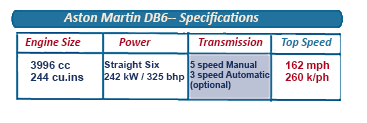 he DB6's bodywork was constructed from aluminium alloy, just like its predecessors, but the labour intensive Superleggera construction was dropped in favour of using folded metal for strengthening.
he DB6's bodywork was constructed from aluminium alloy, just like its predecessors, but the labour intensive Superleggera construction was dropped in favour of using folded metal for strengthening.
This production method was much simpler to apply, stronger and no heavier because although more aluminium was used, it dispensed with the need for steel tubing.
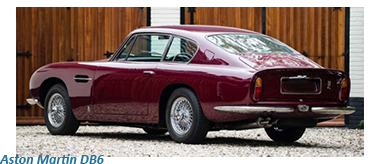 Many were surprised when Aston Martin pulled the rug out from under the DB5, and when the DB6 was launched in October 1966, their dismay continued.
Many were surprised when Aston Martin pulled the rug out from under the DB5, and when the DB6 was launched in October 1966, their dismay continued.
The reason for the motoring press scepticism which spread to the public at large was that the DB6 was virtually identical to its predecessor in appearance.
In fact the DB6 was four inches longer, meaning a marked increase in leg room for rear seat passengers.
The most notable design change that the DB's had been handed were its restyled cut-off tail with itsspoiler lip bringing with it many advantages.
The revamped spoiler was there to reduce the DB6's drag coefficient, and aerodynamic down-thrust on the rear wheels at high speed.
![]()
These refinements meant that the DB6 was a speedy car indeed, and with the optional 325 bhp Vantage engine, it could top 150 mph and streaked from 0-50 mph in a mere 4.9 seconds.
M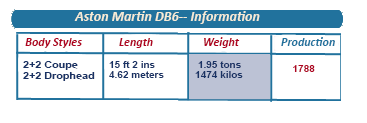 echanically the new model was identical to the DB5 powered by the same Straight six, 3995 cc, 282 bhp apart from altered spring rate.
echanically the new model was identical to the DB5 powered by the same Straight six, 3995 cc, 282 bhp apart from altered spring rate.
Optional automatic transmission, the Borg-Warner Model 8, now offered engine braking in all gears.
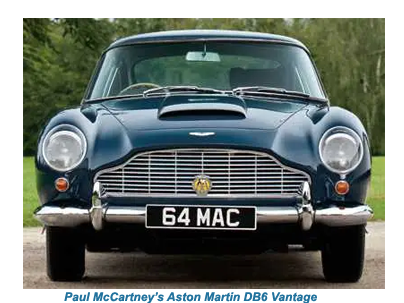 The ZF five-speed manual gearbox was as smooth as ever, with the added advantage of being sound-insulated, with the only reported drawbacks being partial inaccessibility of some controls when strapped in and a weak demisting and ventilation system.
The ZF five-speed manual gearbox was as smooth as ever, with the added advantage of being sound-insulated, with the only reported drawbacks being partial inaccessibility of some controls when strapped in and a weak demisting and ventilation system.
T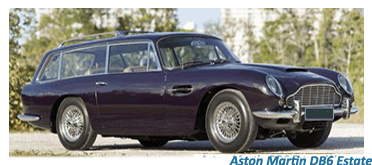 he DB6's interior accommodation was much improved, with much thought having gone into layout and design, the cabin combining comfort and convenience with strict adherence to the new United States Federal Safety Regulations.
he DB6's interior accommodation was much improved, with much thought having gone into layout and design, the cabin combining comfort and convenience with strict adherence to the new United States Federal Safety Regulations.
Shortly after it release, the DB6 four-seater was joined by the new Volante Convertible.
The Volante bore an even stronger resemblance to the DB5.
![]()
Aston Martin did not seem to be at all concerned that the DB6 once again jumped up in weight as it became increasingly apparent that the company were positioning themselves further and further away from their early image of producing big and tough GT cars.
In the Sixties Aston Martin were all about pleasantly appointed high-speed transport in the Bristol and Jensen vein

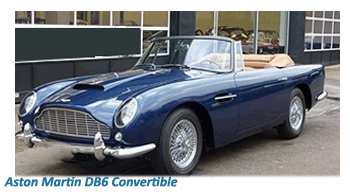 The latest version of the DB6 received unprecedented acclaim, for, despite its considerable weight, the car's 4-litre engine still could reach a maximum speed of around 145 mph and rocket it from 0-50 mph in 5.6 seconds and to 100 mph in only 18 seconds.
The latest version of the DB6 received unprecedented acclaim, for, despite its considerable weight, the car's 4-litre engine still could reach a maximum speed of around 145 mph and rocket it from 0-50 mph in 5.6 seconds and to 100 mph in only 18 seconds.
With all that power at their disposal, Aston Martin DB6 owners could now enjoy the opportunity to put their foot down with almost complete safety with the most striking feature of the car remaining its sure handling.





